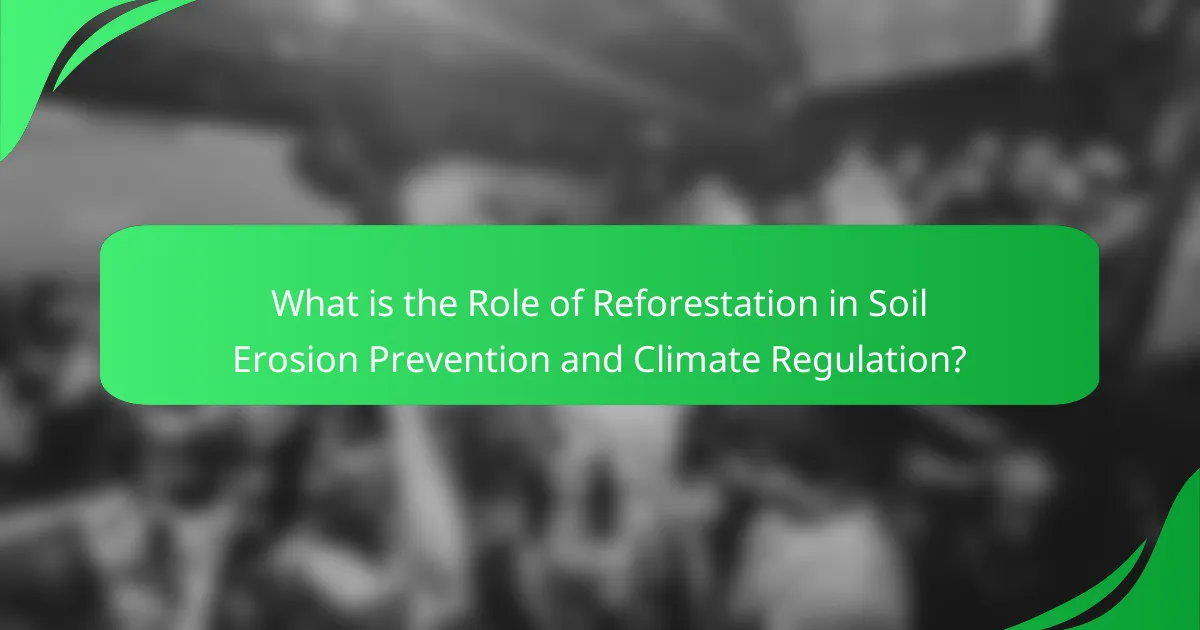Reforestation is a critical environmental process that involves planting trees to restore ecosystems, prevent soil erosion, and regulate climate. This practice stabilizes soil through root systems, reducing erosion caused by wind and water, while also enhancing water retention. Additionally, reforestation sequesters carbon dioxide, contributing to climate change mitigation and improving local climate conditions. The article explores the multifaceted benefits of reforestation, including its role in enhancing biodiversity, improving air quality, and maintaining the water cycle. It also emphasizes the importance of site assessments, community engagement, and proper planning for successful reforestation projects.

What is the Role of Reforestation in Soil Erosion Prevention and Climate Regulation?
Reforestation plays a crucial role in preventing soil erosion and regulating climate. It restores vegetation cover, which stabilizes soil through root systems. These roots hold soil particles together, reducing the risk of erosion from wind and water. Additionally, reforestation enhances water retention in the soil, minimizing runoff and further erosion.
In terms of climate regulation, reforestation helps sequester carbon dioxide from the atmosphere. Trees absorb CO2 during photosynthesis, mitigating greenhouse gas effects. Research indicates that one hectare of forest can absorb approximately 10 to 20 tons of CO2 annually. This process contributes to climate change mitigation by lowering atmospheric carbon levels.
Furthermore, reforestation improves local climate conditions. It increases humidity and reduces temperatures, creating a more stable environment. This can lead to enhanced biodiversity and improved ecosystem services. Overall, reforestation is vital for both soil erosion prevention and climate regulation, offering environmental benefits that support sustainability.
How does reforestation contribute to soil erosion prevention?
Reforestation contributes to soil erosion prevention by stabilizing soil with tree roots. The roots of trees anchor the soil, reducing the likelihood of erosion caused by wind and water. Additionally, tree canopies intercept rainfall, decreasing the impact of raindrops on the soil surface. This interception minimizes soil displacement and compaction. Furthermore, the organic matter from fallen leaves enriches the soil, enhancing its structure and water retention. Studies show that areas with trees have significantly lower erosion rates compared to deforested regions. For example, reforested sites can reduce soil erosion by up to 90% compared to bare land.
What mechanisms are involved in soil stabilization through reforestation?
Reforestation stabilizes soil through several mechanisms. Tree roots anchor the soil, preventing erosion. Their root systems create a network that holds soil particles together. This reduces surface runoff and increases water infiltration. Trees also enhance soil structure by adding organic matter through leaf litter and decomposing roots. The presence of vegetation reduces the impact of raindrops on the soil surface, minimizing soil displacement. Additionally, reforestation can improve microbial activity, further enhancing soil health and stability. Studies show that reforested areas experience significantly lower erosion rates compared to deforested regions.
How do tree roots prevent soil erosion?
Tree roots prevent soil erosion by anchoring the soil in place. They create a network that stabilizes the ground. This network reduces the impact of rainfall on the soil surface. The roots absorb water, which decreases runoff. As a result, less soil is washed away. Additionally, tree roots improve soil structure. They create channels that enhance water infiltration. Studies show that areas with dense tree cover experience significantly less erosion compared to deforested regions.
What impact does reforestation have on climate regulation?
Reforestation significantly impacts climate regulation by enhancing carbon sequestration. Trees absorb carbon dioxide from the atmosphere during photosynthesis. This process helps mitigate climate change by reducing greenhouse gas concentrations. A study by the Intergovernmental Panel on Climate Change indicates that reforestation can sequester up to 1.1 gigatons of carbon annually. Additionally, reforestation improves local climate conditions by increasing humidity and reducing temperature extremes. It also helps in stabilizing soil, which prevents erosion and maintains ecosystem balance. Overall, reforestation is a crucial strategy for climate regulation and environmental sustainability.
How does reforestation influence carbon sequestration?
Reforestation significantly enhances carbon sequestration. It increases the number of trees, which absorb carbon dioxide from the atmosphere. Trees store carbon in their biomass, including trunks, branches, and roots. A mature forest can sequester approximately 2.6 billion metric tons of carbon annually. This process mitigates climate change by reducing greenhouse gas levels. Additionally, reforestation restores ecosystems, improving soil health and biodiversity. Healthy soils can retain more carbon, further contributing to carbon sequestration. Research indicates that reforestation can be a cost-effective climate solution, with potential to offset emissions from various sectors.
What role do forests play in regulating local weather patterns?
Forests play a crucial role in regulating local weather patterns. They influence humidity levels through transpiration, releasing water vapor into the atmosphere. This process contributes to cloud formation and precipitation. Forests also provide shade, which can lower local temperatures. They mitigate extreme weather events by acting as windbreaks and reducing soil erosion. Studies show that areas with dense forests experience more stable weather conditions. For instance, research indicates that deforestation can lead to increased temperatures and altered rainfall patterns. Hence, forests are essential for maintaining local climatic balance.

Why is reforestation essential for environmental health?
Reforestation is essential for environmental health because it restores ecosystems and enhances biodiversity. Healthy forests absorb carbon dioxide, helping mitigate climate change. They also improve air quality by filtering pollutants. Additionally, reforestation prevents soil erosion by stabilizing the ground with root systems. This process protects waterways from sedimentation and pollution. Forests play a crucial role in the water cycle, maintaining local and regional climates. According to the Food and Agriculture Organization, reforestation can increase forest cover and improve ecosystem services. These benefits collectively contribute to a healthier environment.
What are the ecological benefits of reforestation?
Reforestation provides significant ecological benefits. It enhances biodiversity by creating habitats for various species. Reforestation also improves soil quality. Tree roots stabilize the soil and prevent erosion. It helps in carbon sequestration, reducing atmospheric CO2 levels. According to the Intergovernmental Panel on Climate Change, reforestation can sequester up to 1.1 gigatons of carbon annually. Additionally, reforestation contributes to water cycle regulation. Trees promote rainfall and maintain groundwater levels. Overall, reforestation plays a crucial role in combating climate change and preserving ecosystems.
How does reforestation enhance biodiversity?
Reforestation enhances biodiversity by restoring habitats for various species. It provides food and shelter for wildlife, promoting species richness. Increased tree cover creates microclimates that support diverse plant and animal life. The restoration of native species helps maintain ecological balance. According to a study published in “Nature” by Benayas et al., reforestation can increase species diversity by up to 30%. This process also facilitates the recovery of ecosystems that have been degraded. Healthy ecosystems support pollinators and other vital organisms. Ultimately, reforestation plays a crucial role in preserving global biodiversity.
In what ways does reforestation improve water quality?
Reforestation improves water quality by enhancing filtration, reducing runoff, and stabilizing soil. Trees absorb water and slow down its movement, allowing contaminants to settle. This process reduces sedimentation in water bodies. Additionally, roots prevent soil erosion, which often leads to water pollution. Studies indicate that forested watersheds have lower levels of pollutants compared to deforested areas. For instance, a study in the Journal of Environmental Management found that reforested areas significantly decreased nitrates in nearby streams. Overall, reforestation plays a crucial role in maintaining clean and healthy water systems.
What social and economic benefits arise from reforestation?
Reforestation provides significant social and economic benefits. It enhances local livelihoods by creating jobs in forestry and conservation sectors. Communities gain access to resources like timber and non-timber forest products, which support local economies. Reforested areas improve ecosystem services, including water purification and soil fertility. These improvements lead to increased agricultural productivity. Additionally, reforestation contributes to carbon sequestration, helping mitigate climate change effects. According to the Food and Agriculture Organization, reforestation can increase national income through sustainable forest management practices. Overall, reforestation fosters community resilience and economic stability.
How does reforestation support local communities?
Reforestation supports local communities by providing economic opportunities and enhancing environmental stability. It creates jobs in tree planting, maintenance, and sustainable forestry practices. These jobs can significantly reduce poverty in rural areas. Additionally, reforestation improves soil quality and reduces erosion. Healthy soil promotes agriculture, ensuring food security for local populations. Furthermore, reforested areas can attract eco-tourism, generating further income. Studies show that communities engaged in reforestation see improved water quality and availability. This directly benefits agriculture and daily living conditions. Overall, reforestation fosters resilience and sustainability in local communities.
What economic opportunities are created through reforestation initiatives?
Reforestation initiatives create various economic opportunities. These include job creation in forestry management and planting activities. Local communities benefit from employment in sustainable timber production. Eco-tourism can thrive as reforested areas attract visitors. Additionally, reforestation enhances ecosystem services, which can lead to increased agricultural productivity. Carbon credits can be generated, providing financial incentives for landowners. Studies show that every dollar invested in reforestation can yield significant economic returns. For example, the World Resources Institute highlights that reforestation can generate $7.1 trillion in economic benefits globally by 2030.

How can we effectively implement reforestation projects?
To effectively implement reforestation projects, it is essential to conduct thorough site assessments. This ensures the selected areas are suitable for tree planting. Engaging local communities fosters support and participation in the project. Utilizing native species enhances biodiversity and increases survival rates. Proper planning includes creating a detailed action plan outlining goals, timelines, and responsibilities. Monitoring and maintenance are crucial for long-term success. Research shows that well-maintained reforestation projects can restore ecosystems and improve soil health. According to the Food and Agriculture Organization, reforestation can sequester significant amounts of carbon dioxide, aiding climate regulation.
What best practices should be followed in reforestation efforts?
Best practices in reforestation efforts include selecting native species, ensuring genetic diversity, and employing appropriate planting techniques. Using native species enhances ecosystem resilience. Genetic diversity helps forests adapt to changing conditions. Proper planting techniques, such as spacing and depth, promote healthy growth. Additionally, monitoring and maintenance are crucial for long-term success. Regular assessments can identify issues early. Engaging local communities fosters stewardship and increases project sustainability. Research indicates that these practices significantly improve reforestation outcomes. For example, a study by the Food and Agriculture Organization found that diverse, native plantings can restore ecosystems more effectively than monocultures.
How do we select appropriate tree species for reforestation?
Selecting appropriate tree species for reforestation involves assessing ecological compatibility and site conditions. Key factors include soil type, climate, and native biodiversity. Species should be chosen based on their growth rates, resilience to local pests, and ability to improve soil health. Additionally, selecting native species enhances ecosystem stability and supports wildlife. Research indicates that native trees often establish better and adapt more effectively to local conditions. For example, a study by the USDA Forest Service emphasizes the importance of matching species to specific environmental conditions for successful reforestation outcomes.
What methods ensure the success of reforestation projects?
Successful reforestation projects utilize several key methods. These methods include selecting native species, ensuring proper site preparation, and employing community involvement. Native species are better adapted to local conditions and promote biodiversity. Proper site preparation, such as soil testing and clearing invasive species, enhances growth conditions. Community involvement fosters stewardship and ensures ongoing maintenance. Effective monitoring and adaptive management are also crucial for long-term success. Studies show that projects with community engagement have higher survival rates. For instance, the World Resources Institute reports that community-led initiatives can increase tree survival by up to 80%.
What challenges do reforestation projects face?
Reforestation projects face several significant challenges. One major challenge is securing adequate funding, as many projects rely on external grants or donations. Limited financial resources can hinder project initiation and sustainability. Another challenge is selecting appropriate tree species that are suited to local conditions. Inappropriate species selection can lead to poor survival rates and ecological imbalance.
Additionally, reforestation projects often contend with land-use conflicts. Competing interests, such as agriculture or urban development, can restrict available land for reforestation. Climate change also poses a challenge, as shifting weather patterns can affect tree growth and survival.
Moreover, ensuring community involvement is critical. Without local support, projects may struggle with maintenance and protection of newly planted areas. Lastly, monitoring and evaluating the success of reforestation efforts can be difficult, as it requires ongoing resources and expertise. These challenges must be addressed to achieve successful reforestation outcomes.
How can we overcome obstacles in reforestation implementation?
To overcome obstacles in reforestation implementation, effective planning and community involvement are essential. Engaging local communities fosters ownership and commitment. Providing education on the benefits of reforestation encourages participation. Securing adequate funding ensures resources for long-term projects. Utilizing native species enhances survival rates and ecosystem compatibility. Implementing adaptive management practices allows for flexibility in response to challenges. Collaborating with governmental and non-governmental organizations can amplify efforts and resources. According to the Food and Agriculture Organization, successful reforestation projects often involve multi-stakeholder partnerships.
What role does community involvement play in successful reforestation?
Community involvement is crucial for successful reforestation. Engaging local populations fosters a sense of ownership and responsibility. This leads to better care and maintenance of newly planted trees. Studies show that projects with community participation have higher survival rates for saplings. For example, a study by the World Resources Institute found that community-led initiatives can increase tree survival rates by up to 80%. Additionally, local knowledge contributes to selecting appropriate species for the area. This ensures that reforestation efforts are ecologically viable. Community involvement also helps in raising awareness about the importance of forests. Increased awareness can lead to more sustainable practices in land use and conservation. Overall, community engagement enhances the effectiveness and sustainability of reforestation projects.
What are practical steps individuals can take to support reforestation?
Individuals can support reforestation by planting trees in their local communities. Engaging with local tree-planting organizations enhances the impact of individual efforts. Donating to reforestation projects provides financial support for larger initiatives. Educating others about the benefits of trees fosters community involvement. Reducing paper usage decreases the demand for logging, indirectly supporting forests. Choosing sustainable products helps protect existing forests from deforestation. Advocating for policies that promote reforestation influences broader environmental practices. Participating in local clean-up events helps maintain existing green spaces, supporting overall ecosystem health.
The main entity of the article is reforestation, which plays a critical role in preventing soil erosion and regulating climate. The article outlines how reforestation stabilizes soil through tree root systems, enhances carbon sequestration, and improves local climate conditions. It discusses the mechanisms by which reforestation prevents erosion, its ecological benefits, and the social and economic advantages for local communities. Additionally, the article addresses challenges faced in reforestation efforts and emphasizes the importance of community involvement and effective planning for successful implementation.